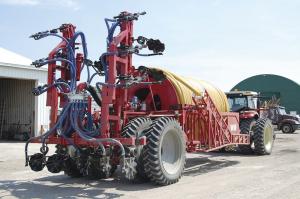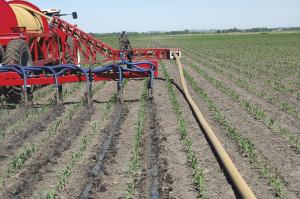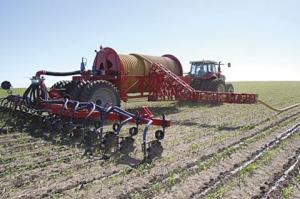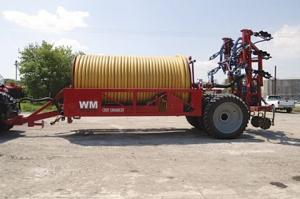2010 - Volume #34, Issue #5, Page #03
[ Sample Stories From This Issue | List of All Stories In This Issue | Print this story
| Read this issue]
"Crop Enhancer" Spreads Manure In Standing Row Crops
 |
 |
 |
 |
"Too often in the spring, it's too wet to apply manure before the corn goes in," says Walter Manders. "Later in the year, when the crop is up, it's usually nice and dry in the row."
The brothers used off-the-shelf components when they could and fabricated the rest, such as the 45-ft. tool bar with wings that folds three times to a transport width of 12 ft. Any wider and transport down the road would require a special permit in Ohio.
Any manure pump capable of supplying a drag hose system can be used with the Crop Enhancer. The manure goes through a Vogelsang hydraulic distribution manifold that delivers equal amounts of manure to each 2-in. distribution tube and injector.
The hose and toolbar components are standard off-the-shelf units. "Our first unit used double disks, but the current toolbar has rolling coulters with 8, 2-in. waves and injection tubes mounted behind them," he says. "You can add equipment as needed; for example, Iowa requires the manure be covered, but here in Ohio it isn't required. At the time of the year we are applying, the ground soaks it up fast, and the corn needs all the moisture it can get."
The hose reel, guide bar and toolbar are unique. At 17 ft. long and 5 ft. in diameter, the reel holds 3,900 ft. of 4-in. dia., lay-flat manure hose. The reel is chain-driven off a hydraulic-driven sprocket.
The 15 ft. long hose guide is also chain driven. It's calibrated to move back and forth across the reel with the hose as it unwraps and wraps on the reel.
"The calibration is likely the most important part of the entire machine," says Manders. "It also had to be calibrated so when all the hose has wrapped up, the guide is at the rear of the reel. We just pull two pins and fold it forward against the frame."
The hose guide is what allows the 16-row, 30-in. row Crop Enhancer to be used after the crop is up. It lays the hose down between crop rows. When the operator reaches the end of the field and turns around, the hose guide picks the hose back up.
As the hose is laid out, it falls in a row space that would otherwise have a rolling coulter and injector running down it. To avoid slicing the hose as it's unrolled, the tip of the toolbar with the last coulter and injector on the hose side is tipped back on the toolbar wing. This action also pinches off the flat hose serving it, shutting off the flow of manure. When the system has reversed and the hose is being picked up, the toolbar section is tipped back into place hydraulically, and the row space is again tilled and injected. An identical unit at the other end of the toolbar is always in reverse position. When one tip is up, the other is down. There are always 16 units distributing manure.
"In order to maintain an even flow of manure, we couldn't have one unit being shut off and on with the excess flow going to the other tubes," explains Walter.
The toolbar itself consists of a stationary 12-ft. width behind the Vogelsang manifold. Each 16 1/2-ft. wing is designed to fold twice (not counting the tip section).
The entire unit is 37 ft. from end to end and rides on four Michelin 380/90/R46 row crop tires. Each pair of tires straddles a row. The low-pressure tires have a high load capacity, which they need.
"The fully loaded trailer weighs 15 tons on the axles and 6 tons on the hitch," says Manders. "People say that's a lot of weight, but with these tires, we do less damage to the soil than a 1,000-gal. tank of liquid fertilizer on 13-in. wide tires."
The weight is a determining factor for the size tractor needed to pull the Crop Enhancer. While a 70-hp tractor could pull it, it needs something closer to 150-hp to handle the weight at the hitch. A pto-driven hydraulic pump that can put out about 80 gpm, handles all the onboard power.
"Everything is electric-over-hydraulic controlled from a small box in the cab with a joystick," says Manders. "It's very low pressure, so we don't need much power. In fact, the tractor can run at 1,500 rpm's all day."
The brothers sold their first generation prototype to an Iowa farmer. Manders estimates the price of a new unit at $140,000. Currently he's evaluating the market for interest before deciding to build more units.
Contact: FARM SHOW Followup, Manders Dairy, LLC, 11190 Range Line Rd., Weston, Ohio (ph 419 669-1070; waltermanders@hotmail.com).

Click here to download page story appeared in.

Click here to read entire issue
To read the rest of this story, download this issue below or click here to register with your account number.




